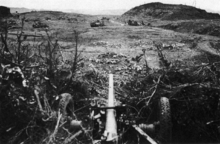47 mm anti-tank gun type 1
| 47 mm anti-tank gun type 1 | |
|---|---|
| General Information | |
| Military designation: | 一 式 機動 四 十七 粍 速射砲 |
| Manufacturer country: |
|
| Development year: | 1941 |
| Production time: | 1941 to 1945 |
| Number of pieces: | 1961 |
| Weapon Category: | Anti-tank |
| Technical specifications | |
| Pipe length: | 2.53 m |
| Caliber : |
47 mm |
| Caliber length : | L / 54 |
| Weight ready for use: | 805 kg |
| Elevation range: | −10 ° to +18 degrees |
| Side straightening area: | 58 ° |
| Furnishing | |
| Closure Type : | Screw lock |
| Ammunition supply: | individually |
The 47-mm anti-tank gun type 1 ( Japanese 一 式 機動 四 十七 粍 速射砲 , Isshiki Kidō Yonjūnana-miri Sokushahō , German "Type 1 mobile 47-mm rapid fire gun") was an anti-tank gun (Pak), which was used by the Imperial Japanese Army was used in the Second Sino-Japanese War and during the Pacific War from 1941 to 1945. The designation type 1 indicates the year of development, the year Kōki 2601 or 1941 according to the Gregorian calendar.
The Type 1 was the most powerful, mass-produced anti-tank cannon of the Japanese anti-tank companies and battalions, which was used during World War II.
history

The Imperial Japanese Army had paid little attention to the development of anti-tank weapons in the 1920s and focused primarily on artillery infantry support. This changed abruptly when tensions with the Soviet Union ( Japanese-Soviet border conflict ) arose in the early 1930s , as it had considerable armored weapons. In 1934 the 37-mm anti-tank gun Type 94 was introduced into the army, which was the army's first anti-tank gun built exclusively for this purpose. In 1937 an attempt was made to increase the penetration power of the Type 94 Pak with a longer shell, but it remained at the experimental status. In 1941, the army command decided to use a larger caliber and the Osaka arsenal was commissioned to develop the 47-mm Type 1 anti-tank gun. The first examples were delivered in April 1942 and, compared to the 37 mm version, had an almost 50% greater penetration at a distance of 500 m. Most of the 1961 copies produced remained on the main Japanese islands to be available for the feared Allied invasion . Some Paks have been shipped to larger Japanese-occupied Pacific islands, including Luzon and Okinawa , where they have been used successfully.
The Type 1 remained in service until the end of the Second World War . After the surrender of Japan, some of the guns remained in the formerly occupied countries and were used there.
technology

The 47 mm Type 1 anti-tank gun was a modern anti-tank gun for the time. In principle, the Type 1 anti-tank gun was a further development of the 37 mm anti-tank gun type 94. The barrel was lengthened to 2.53 m and the profile of the cannon had become lower.
Technical details
- Caliber: 47 mm
- Caliber length: L / 54
- Pipe length: 2.53 m
- Elevation range: −10 ° to + 18 °
- Side straightening range: 58 °
- Gun weight: 800 kg
- Muzzle velocity V 0 = 827 m / s
- Maximum range: 6,900 m
gallery
A Type 1 on display at the Battery Randolf US Army Museum, Honolulu
Bullet holes in an M4A3 Sherman tank by a Type 1 anti-tank gun
literature
- Gordon L. Rottman : Japanese Army in World War II, The South Pacific and New Guinea, 1942-43. Osprey Publishing, 2005, ISBN 978-1-84176-870-0 .
- Chris Bishop: The Encyclopedia of Weapons of World War II. Barnes & Nobel, 1998, ISBN 978-1-78274-167-1 .
- Leland Ness: Guide to Japanese Ground Forces 1937-1945: Volume 2: Weapons of the Imperial Japanese Army & Navy Ground Forces. Helion & Company, 2014, ISBN 978-19099-8275-8 .
Web links
- Type 1 47mm anti-tank gun. Taki's homepage, accessed March 30, 2015 .
- Chapter f. Model 1 (1941) 47-mm tank gun. Handbook on Japanese Military Forces, September 1944, accessed December 22, 2014 .
- Japan's Battle of Okinawa, April-June 1945. Combined Arms Research Library, accessed February 22, 2017 .
- Japanese 47-mm AT Gun. US War Department, Tactical and Technical Trends, No. 43, accessed February 22, 2017 .
Individual evidence
- ↑ a b Ness, p. 92.
- ↑ a b c Type 1 47mm Anti-Tank Gun. Taki's homepage, accessed March 30, 2015 .
- ↑ a b Ness, p. 94.
- ↑ Chapter d. Model 1 (1941) 47-mm tank gun. Handbook on Japanese Military Forces, September 1944, accessed December 22, 2014 .






